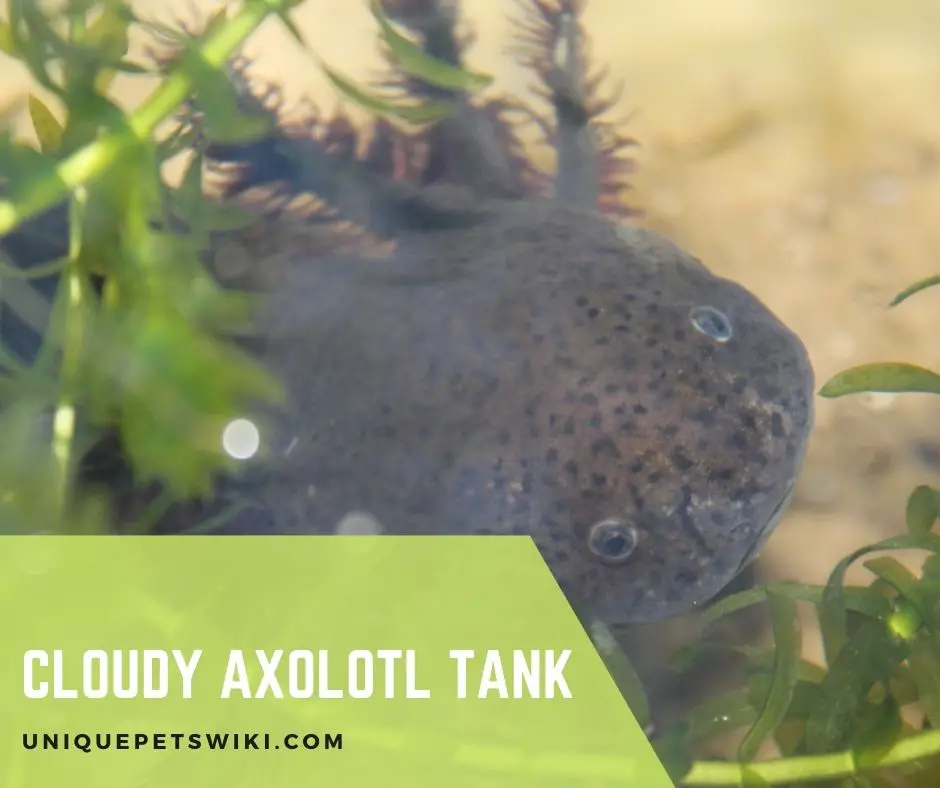Cloudy axolotl tank is one of the commonest of issues faced by axolotl owners.
Everything is fine one day, and suddenly, out of nowhere, your tank water appears cloudy. You may have changed at least 40% water daily, and yet the cloudiness persists.
It is important that you find out the root cause behind the cloudy axolotl tank as there could be bacterial blooms or excess ammonia that may be causing it.
If those are the reasons behind the murky water, then you must act quickly and limit your pet’s exposure to these issues.
Let us study the causes, solutions, and preventive measures behind axolotl tank cloudy water.
Contents
What Causes Cloudy In Axolotl Tank? How to Fix It and Maintain Good Water Quality?
There can be several reasons why your axolotl tank is cloudy, such as a bacterial bloom, too many organic wastes or even an overabundance of algae growth.
One of the best ways to prevent cloudiness in your tank is to maintain regular water changes and make sure you aren’t adding too much food.
Additionally, try using an aquarium filter to help keep your axolotl tank clean and clear. If your tank is still cloudy after taking these steps, it’s best to consult a professional to find out the root cause of the problem.
Why Is Your Axolotl Tank Water So Cloudy?
A number of factors can cause axolotl’s tank water to become cloudy. The most common reason behind a cloudy tank is bacterial bloom in axolotl tank that can occur due to a variety of factors:
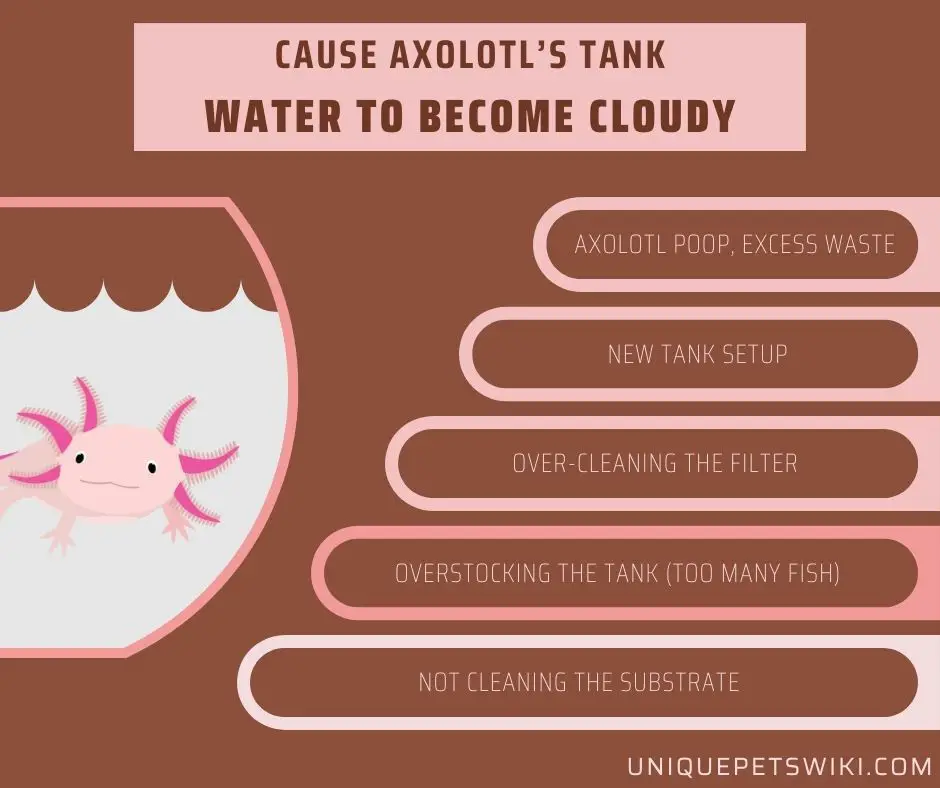
- Axolotl Poop, Excess Waste
Bacterial bloom occurs due to organic waste that can decay and cause the tank water to get cloudy. The waste can come from axolotl’s poop, dead plants, dead fish, dead snails, etc.
These cause a rise in the reproduction of the heterotrophs or heterotrophic bacteria which break down the organic waste.
These bacteria have the ability to double their population every few minutes resulting in cloudy tank water.
Excess waste and excess food also give off ammonia and nitrites.
If you do not promptly clean away all of the uneaten food, it can also disturb the ammonia and nitrite level in the water and make the water take on a milky white appearance.
- New tank setup
After starting a new tank, it is not uncommon to have the water cloudy in its early days.
This is mainly due to beneficial bacteria that convert nitrogen and oxidize ammonia and nitrites. A sudden increase in these chemicals can cause the water to get cloudy.
Also read: 3 Best Axolotl Aquarium Setup Ideas
- Over-Cleaning The Filter
If cloudy water occurs after tank cleaning, filter cleaning, or after stirring up the substrate, then the cloudiness may be due to the excessive release of organic materials and the bacterial bloom that follows it.
- Overstocking the Tank (too many fish)
More fish in a tank means more waste. More waste means more food microbes that can cause the water to acquire a milky appearance.
Ideally, axolotls should be housed alone. If you keep other fish or even two axolotls together, then too many tank occupants could result in a harmful rise in ammonia and nitrites.
- Not Cleaning the Substrate
People often clean the tank and filter but forget to stir the substrate. The substrate tends to accumulate algae and uneaten food bits, which can result in the milky appearance of the water.
Dust coming from a new substrate or aquarium décor can add to the water’s cloudiness. That is why it is important to stir the new substrate and old substrate every few months.
Sometimes, you may noticed that the water is cloudy and also a bit green
Risks when Cloudy Axolotl Tank
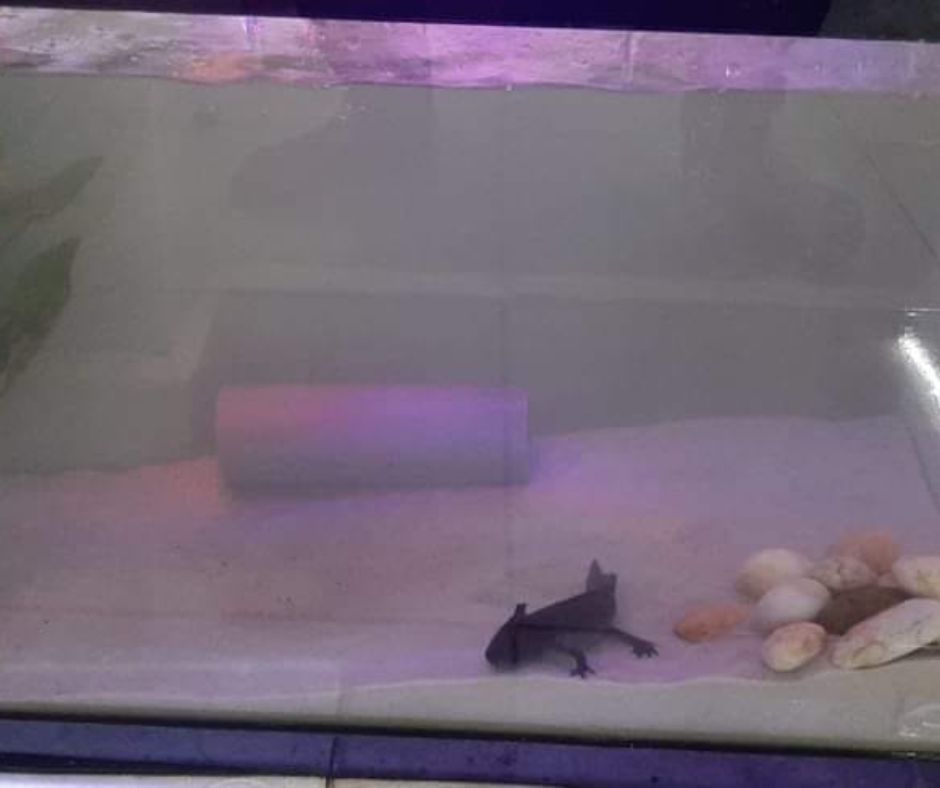
The health risks of a cloudy axolotl tank to an axolotl will actually depend on the cause of the cloudiness.
On its own, cloudy water may not harm your axolotl as long as the water parameters are fine and there are no bacterial blooms.
However, if the ammonia levels are high or there are bacteria, uneaten food, and dead organic waste, then these could result in a slimy build-up on the tank’s walls.
This buildup could harm your axolotl, causing skin issues like bacterial or fungal infections.
Also, the cloudy water will impact your aquarium’s appearance. A clean tank is important to help you watch your tank inhabitants clearly and ensure their wellbeing.
If the water is cloudy or murky, you won’t be able to clearly see what is going inside the tank and that can be dangerous.
Most importantly, prolonged exposure to poor water quality could lead to health issues for all your tank’s inhabitants, including aquatic plants, fish, and other organisms.
AQUANEAT Aquarium Activated Carbon Filter Media Pad
- Activated carbon impregnated filter pad effectively traps large particles, removes discoloration, odor, pollutants, and harmful chemical to keep your aquarium crystal clear
- DIY Cut-to-fit filter pad, good to use in freshwater and saltwater aquariums
- Works with all filters: canister, hang-on filter, wet/dry, pond filters, DIY filters
- To ensure optimum performance, replace the filter pad every three to four weeks depending on waste load of the fish tank
- Includes: 1 pack of filter pad. Each is of 3/8" to 1/2" thick ,thickness measured dry before packing and varies by batch
Last update on 2022-12-29 / Affiliate links / Images from Amazon Product Advertising API
How to Solve Cloudy Tank
Although there are many possible causes of cloudy water, fortunately, there are also many ways to clear it up. The first step in solving the problem is to determine the cause of the cloudy water.
If you suspect that your tank is experiencing cloudy water due to overfeeding, you can start by reducing the number of feedings per day or cutting out certain types of foods.
A clean tank and filter will also help remove unwanted waste and debris.
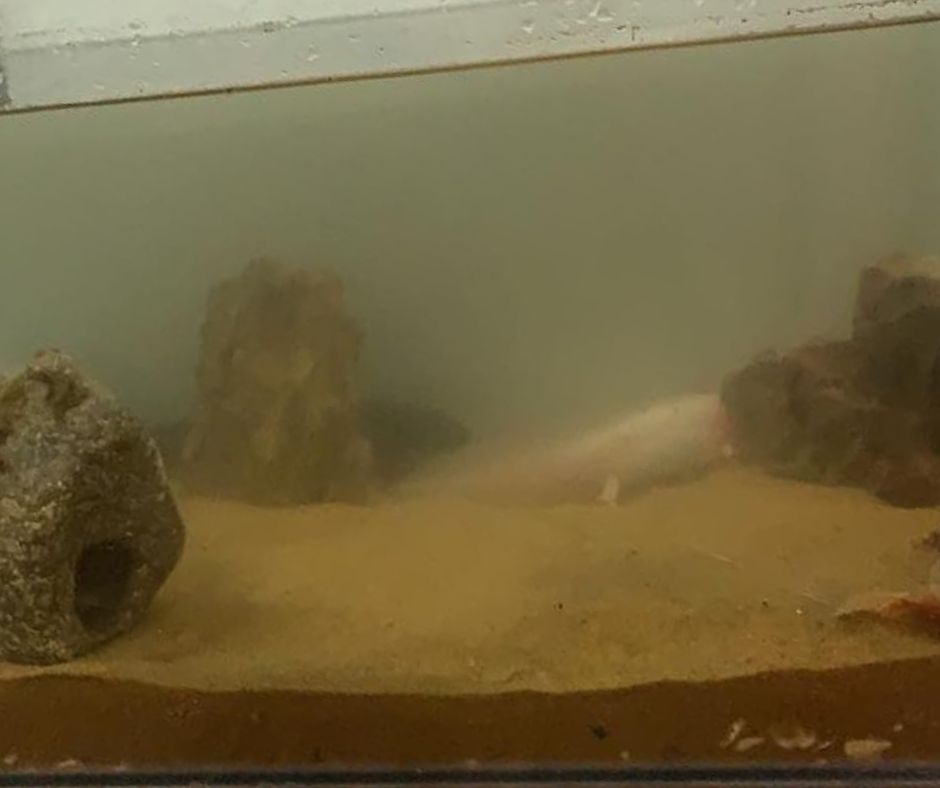
- Remove Your Axolotl To A Separate Tank
Buy a separate tank to quarantine your axolotl while you clean and treat its main tank for the cloudy water. Make sure to place your axolotl in the dechlorinated cool water during this period.
Also read: How to Transfer Axolotl and Prevent Temperature Shock
- Make Large Water Changes Daily
Make at least 80-90% water changes on a daily basis in the main tank and continue doing so for at least 3-4 days. Remember that you should do axolotl water change every week even in normal conditions of water, not only when your tank get super clouldy.
Oftentimes, the water cloudiness will resolve on its own as the tank cycles and the parameters balance and regulate. Test the water with an API kit to ensure optimum parameters.
- Replace the Hang-on-the-Back Filter With a Sponge Filter
In some cases, your aquarium may become cloudy due to problems with the filtration system or other equipment.
In these situations, it may be necessary to improve the filtration by adding additional filters or replacing it.
The Hang-on-the-back or HOB filters are often designed such that, in the event, the filter pad is clogged, they allow the water to flow around or above the pad.
Many HOB filters also tend to restrict water movement and scatter the waste back into the tank. If you have been using a HOB filter, it may be time to switch to a sponge filter.
Sponge filters often allow better mechanical filtration than other types of filters. They also increase the population of beneficial bacteria and create a more balanced ecosystem.
- Add Activated Carbon to the Filter Media
This is the simplest way to keep your aquarium water clear. Activated carbon acts as a chemical filter and clears away cloudiness as well as odors.
These days, you get activated carbon filter media pads or loose activated carbon specifically made for use with aquarium filters.
If you are using loose carbon, just 1/4 cup of it per week to a 75-gallon tank – this will keep your water crystal clear.
If you are still having trouble solving the problem, you may need to consult with a professional fish keeper or aquarium specialist.
They can offer advice on how to improve your tank’s environment and provide helpful tips on preventing cloudy water in the future.
How to Avoid Your Axolotl Tank Becomes Cloudy?
Prevention is often the best cure and it is always better to take preventive steps to avoid cloudy axolotl tanks. There are a number of things you can do to prevent axolotl water from getting murky or cloudy.
- Use a Bigger Tank
A single axolotl should be housed in a tank that is at least 20 to 30 gallons in size. Always remember: the larger the better.
A larger tank also means more water volume and greater dilution of the waste. This can give your water a ‘clearer’ look.
Also read: 10 Steps to Setup an Axolotl Tank
- Switch to Better Filtration
Consider your filter’s water turnover rate. Filters are rated using a “gallons per hour” (or GPH) rating. Select your filter’s GPH rating based on your tank size. Normally, small tanks of 30 gallons do well with a filter of 200 GPH.
As recommended earlier, switch to sponge filters as they efficiently help clear the water. Sponge filters are also perfect for delicate creatures like axolotls that do not need a very strong flow.
- Make Sure You Stir Substrates Before Adding Them
Before adding the substrate to a new tank, stir it up to remove dust. This is important to prevent your tank water from clouding up at the very beginning.
Also, over time, aquarium substrate tends to accumulate algae, dust, and other contaminants. So you must remember to stir it every now and then so that the dust comes off and your tank’s filter can clear it.
You must especially stir the substrate if you use an under-gravel filter. These tend to pull the waste deeper into the gravel and that may start clogging its water flow.
- Spot Cleaning
Weekly spot cleaning can help your tank stay clearer between water changes.
During spot cleaning, remove any food that isn’t eaten right away and also remove fish waste and axolotl poop. You may also want to scrub the tank’s walls.
- Make Frequent Water Changes
Weekly or bi-weekly water changes improve not only your water clarity but its quality as well.
It is recommended that you change at least 80-90% of the water and that is irrespective of whether you use a filter or not.
Also read: How to Keep An Axolotl Tank Clean
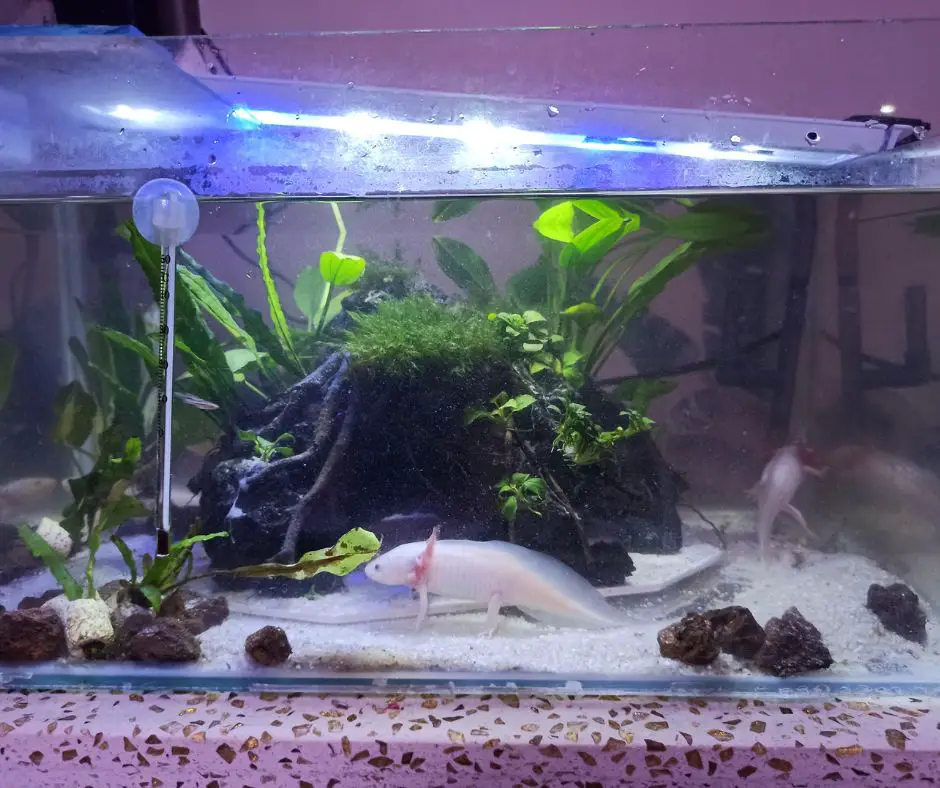
Conclusion – Cloudy Axolotl Tank
There are a number of factors that can cause a cloudy axolotl tank. Mostly, it is bacterial blooms caused by excess ammonia, unclean or dusty substrate, accumulated axolotl poop, and improper filtration.
We hope the above guide helps you pinpoint the cause of the cloudy axolotl tank and also take corrective actions to prevent it.
